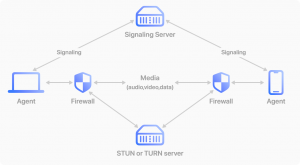Orlando, Florida Dec 7, 2022 (Issuewire.com) - A technology for streaming video and live events is drawing the market's attention and is changing the way an online transmission is made, without the need to use a content delivery network (CDN). WebRTC (Web Real-Time Communication) technology uses point-to-point (P2P) communication to connect the content sender to the receiving public.
Created in 1999 by Global IP Solutions (GIPS) in Sweden, WebRTC (Web Real-Time Communication) technology is a collection of protocols, standards, and JavaScript APIs that allow peer-to-peer communication on the Web without the need for a CDN (a network delivery systems) and enables ultra-low latency (less than 500 milliseconds) audio and video streaming, including signaling, STUN, TURN, and ICE protocols.
The technologies involved in WebRTC are implemented as an open web standard and are available as JavaScript APIs supported by major web browsers including Apple, Google, Microsoft, and Mozilla. A vast library of functionality for native clients, such as Android and iOS apps, is also available to developers
GIPS had already developed many of the codecs and echo cancellation techniques that underpin real-time communication, and when Google acquired this VoIP (voice over IP) and videoconferencing company in 2010, these real-time communication components were transformed into a browser-based open source project, which has driven standardization by the W3C (World Wide Web Consortium). Although it also acts as a streaming protocol, it can work in conjunction with Real-Time Messaging Protocol (RTMP), Real-Time Streaming Protocol (RTSP), and WebRTC HTTP Ingestion Protocol (WHIP).
Because it is an open-source technology, its source code is available to anyone who wants to use it, allowing a community of developers to come together and improve the technology. Furthermore, it is platform-independent, and its streaming protocols are browser-based, requiring no hardware or other equipment.
Its security is standardized via Standard WebRTC Workflow, which allows you to enforce your own security measures, including the use of HTTPS for communication with signaling servers and SRTP (Secure Real-time Transport Protocol) for encrypting media files. Its latency is ultra-low, which is another great advantage of the technology, offering faster streaming with less than 500 milliseconds of latency.
Even though it has many advantages, WebRTC technology has some limitations and it works best when connecting two peers in a network. It can stream to multiple end-user devices, but it faces significant challenges, especially after 50 users. Without an adapted workflow that implements a dedicated media server, WebRTC technology is not suitable for larger transmissions, being ideal for smaller events, such as online meetings, training, and webinars, among other online activities.
Where WebRTC technology applications can be used
Applications of WebRTC technology benefit from the fact that it is extremely fast, and therefore suitable for situations where even a few seconds of latency can be disruptive. Below we present some examples of applications of WebRTC technology in different market segments. Here are some usage examples:
- Corporate - WebRTC technology can meet a variety of enterprise streaming needs, including one-on-one communications, interactive group communications, webinars, and meetings.
- Education - While online education has been around for some time, the COVID-19 pandemic has seen a growing and urgent need for it. Fortunately, WebRTC technology is fast and adaptable enough to serve this segment. Able to handle a variety of teaching situations, from one-on-one meetings between teacher and student to interactive lessons for small classes, the technology meets these needs very well.
- Games - Online gamers can have group chat sessions via voice and text while simultaneously playing games that require interaction. The reliability of these communications is important for team-oriented online games.
- E-commerce - Shopping on the Internet has become a standard and moves millions of people who are looking for better prices and the convenience of not having to leave home to make a purchase. Online events allow participants to be offered a button to click and purchase products or services without closing the stream.
- Fitness - WebRTC technology is already being used to connect gyms with users in their homes and workplaces to connect fitness equipment. The goal is to boost interactivity with participants and ensure that these interactive exercise classes are more refreshing and less annoying.
The next steps of WebRTC technology
WebRTC technology is getting stronger every day and therefore we can assume that its future will be more versatile and efficient. The telecom industry will emerge and expand with new streaming technologies based on WebRTC operating over high-speed 5G networks. 5G connections advanced with interactive customer chat and cloud data management.
Rodrigo Cascão Araújo
CEO of EiTV, a global provider of streaming and digital TV platforms, and global technology provider for online content transmission. Headquartered in Brazil, it operates in Latin America and the United States.
Media Contact
EiTV / Rodrigo Cascão Araújo rodrigo@eitv.com.br +1 689 270 6208 407 Nw 10th Terrace https://www.eitvcloud.com









